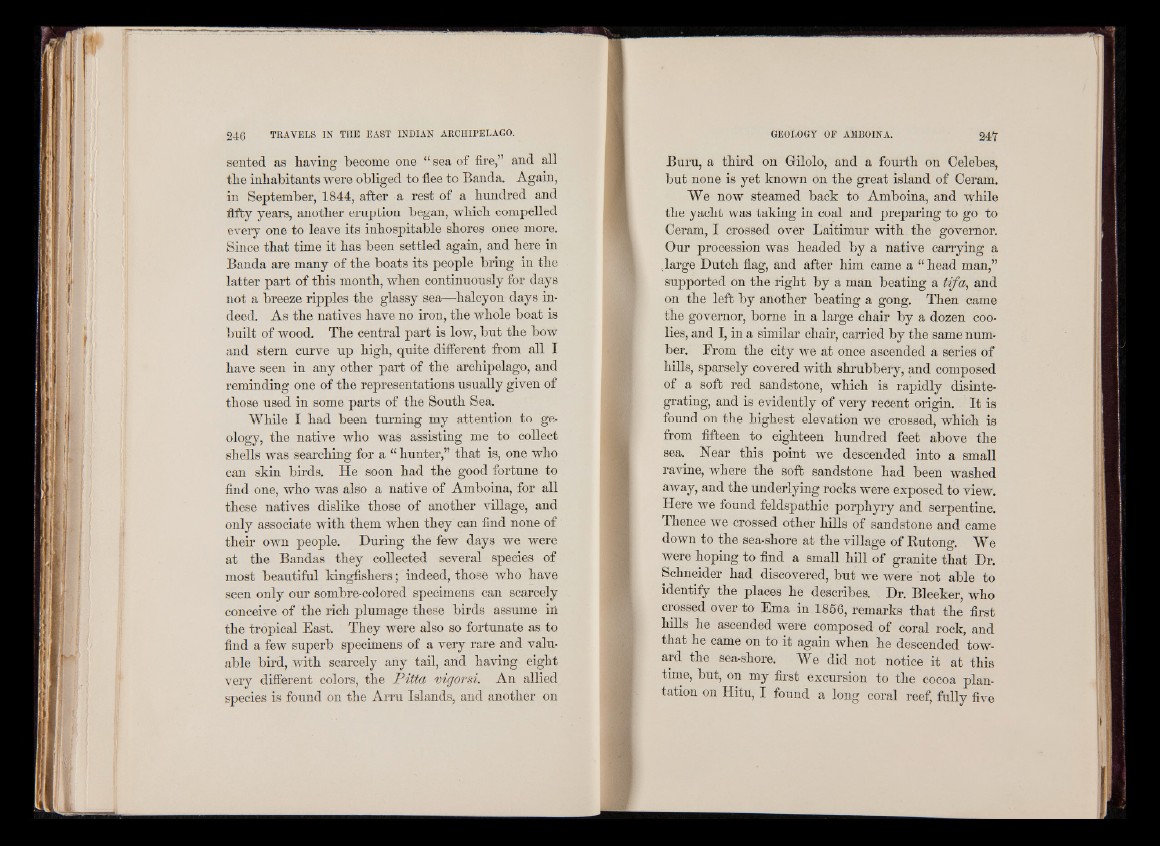
sented as having become one “ sea of fire,” and all
the inhabitants were obliged to flee to Banda. Again,
in September, 1844, after a rest of a hundred and
fifty years, another eruption began, which compelled
every one to leave its inhospitable shores once more.
Since that time it has been settled again, and here in
Banda are many of the boats its people bring in the
latter part of this month, when continuously for days
not a breeze ripples the glassy sea—halcyon days indeed.
As the natives have no iron, the whole boat is
built of wood. The central part is low, but the bow
and stern curve up high, quite different from all I
have seen in any other part of the archipelago, and
reminding one of the representations usually given of
those used in some parts of the South Sea.
While I had been turning my attention to geology,
the native who was assisting me to collect
shells was searching for a “ hunter,” that is, one who
can skin birds. He soon had the good fortune to
find one, who was also a native of Amboina, for all
these natives dislike those of another village, and
only associate with them when they can find none of
their own people. During the few days we were
at the Bandas they collected several species of
most beautiful kingfishers; indeed, those who have
seen only our sombre-colored specimens can scarcely
conceive of the rich plumage these birds assume in
the tropical East. They were also so fortunate as to
find a few superb specimens of a very rare and valuable
bird, with scarcely any tail, and having eight
very different colors, the P itta vigorsi. An allied
species is found on the Arru Islands, and another on
Buru, a third on Gilolo, and a fourth on Celebes,
but none is yet known on the great island of Ceram.
We now steamed back to Amboina, and while
the yacht was taking in coal and preparing to go to
Ceram, I crossed over Laitimur with the governor.
Our procession was headed by a native carrying a
Ilarge Dutch flag, and after him came a “ head man,”
supported on the right by a man beating a tifa, and
on the left by another beating a gong. Then came
the governor, borne in a large chair by a dozen coolies,
and I, in a similar chair, carried by the same number.
From the city we at once ascended a series of
hills, sparsely covered with shrubbery, and composed
of a soft red sandstone, which is rapidly disintegrating,
and is evidently of very recent o r i g i n . It is
found on the highest elevation we crossed, which is
from fifteen to eighteen hundred feet above the
sea. Hear this point we descended into a small
ravine, where the soft sandstone had been washed
away, and the underlying rocks were exposed to view.
Here we found feldspathic porphyry and serpentine.
Thence we crossed other hills of sandstone and came
down to the sea-shore at the village of Butong. e
were hoping to find a small hill of granite that Dr.
Schneider had discovered, but we were not able to
identify the places he describes. Dr. Bleeker, who
crossed over to Ema in 1856, remarks that the first
hills he ascended were composed of coral rock, and
that he came on to it again when he descended toward
the sea-shore. We did not notice it at this
time, but, on my first excursion to the cocoa plantation
on Hitu, I found a long coral reef, fully five